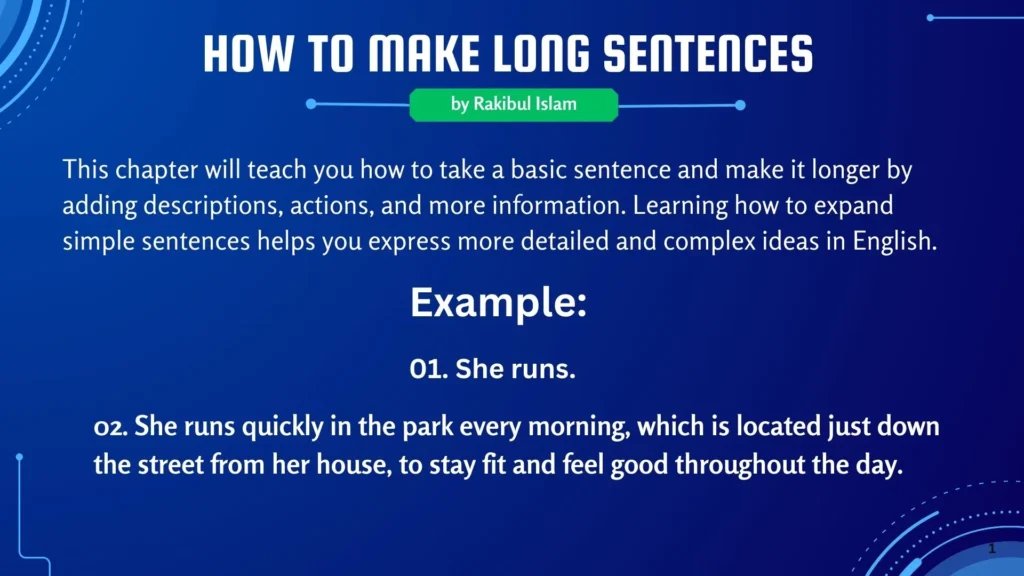Learn How to Make Small Sentence Longer: The Ultimate Guide
| Expanding simple sentences is one of the most effective ways to improve your English language skills, whether you’re learning English as a second language or refining your fluency. By transforming basic, short sentences into detailed and descriptive ones, you can enhance both your writing and speaking abilities. In this comprehensive guide, we’ll explore various techniques for expanding simple sentences, making them more engaging, informative, and sophisticated. Mastering these techniques will allow you to express yourself with greater clarity, confidence, and precision in English. By the end of this article, you’ll know exactly how to turn any simple sentence into a rich, complex one using adjectives, adverbs, conjunctions, prepositional phrases, and more. Let’s dive in! |

Why Expanding Simple Sentences is Essential for English Learners
As an English learner, mastering the ability to expand simple sentences will greatly improve your fluency. Simple sentences are great for clear communication, but they often lack depth and detail. They consist of a subject and a verb, such as:
She runs.
He eats.
They play.
While these sentences are functional, they don’t convey much information. Expanding simple sentences allows you to:
Describe actions in detail.
Provide context.
Express thoughts and emotions more fully.
Learning how to add richness to basic sentences enables you to sound more natural and sophisticated, improving your overall communication skills.
What Are Simple Sentences?
A simple sentence is made up of a subject and a predicate (a verb or action). It expresses a complete thought but is often very basic and may lack important details. For example:
She runs (subject + verb).
He eats (subject + verb).
They play (subject + verb).
These sentences are clear and correct, but they don’t tell us much. To express more nuanced ideas, we need to expand these simple sentences by adding more information. Let’s break down some ways to do that.
Techniques for Expanding Simple Sentences
- Using Adjectives to Describe Nouns
Adjectives are words that describe nouns (people, places, or things). Adding adjectives is an easy and effective way to expand simple sentences and provide more detail.
Example:
Simple Sentence: She runs.
Expanded Sentence: She runs fast.
By adding the adjective fast, we get more information about the way she runs.
Why It Helps: Using adjectives gives your sentences more clarity and richness. It allows you to convey more detailed information, helping your listener or reader visualize what you’re describing.
- Adding Adverbs to Describe the Action
Adverbs describe how, when, where, or to what extent an action happens. They enhance the verb in a sentence, giving more context to the action.
Example:
Simple Sentence: She runs.
Expanded Sentence: She runs quickly in the park.
In this expanded sentence, the adverb quickly tells us how she runs, and the prepositional phrase in the park tells us where.
Why It Helps: Adding adverbs helps learners explain actions with more detail. It enhances communication by giving more specific information about the verb, allowing for a deeper understanding of the action.
- Incorporating Time, Place, or Frequency
Expanding simple sentences with details about time, place, or frequency adds important context. It helps you express when, where, or how often something happens.
Example:
Simple Sentence: He eats.
Expanded Sentence: He eats a red apple every morning before school.
Here, we added a red apple to specify what he eats, and every morning before school to indicate when he eats.
Why It Helps: This method allows learners to practice and improve their understanding of time expressions, locations, and routines, which are crucial for fluency in everyday conversations.
- Using Conjunctions to Combine Ideas
Conjunctions like and, but, because, and so help to join two ideas, giving more detail and making your sentences more complex.
Example:
Simple Sentence: She runs.
Expanded Sentence: She runs every morning, and she enjoys it.
By using the conjunction and, we’ve added another idea: she enjoys running.
Why It Helps: Conjunctions help learners to connect thoughts and make their sentences flow better. This is an essential skill for crafting more natural and sophisticated speech and writing.
- Adding Reasons and Purposes with “Because” or “So”
One powerful way to expand a sentence is by showing cause and effect with conjunctions like because or so. This adds depth by explaining why something happens or its intended purpose.
Example:
Simple Sentence: She runs.
Expanded Sentence: She runs because she wants to stay fit.
Here, because introduces the reason why she runs.
Why It Helps: Adding reasons helps learners think critically and express motivations, which is especially useful in academic or professional contexts.
- Expanding Sentences with Prepositional Phrases
A prepositional phrase adds more information about the place, time, or direction of an action. These phrases provide additional context and make your sentence more descriptive.
Example:
Simple Sentence: He works.
Expanded Sentence: He works in a busy office downtown.
Here, in a busy office downtown tells us where he works, making the sentence much more informative.
Why It Helps: Prepositional phrases are excellent for improving sentence structure and helping learners give detailed descriptions. These phrases make your sentences more vivid and give context to the action.
- Creating Complex Sentences Using Conjunctions Like “Although” and “Even Though”
To express contrast or exceptions, use conjunctions like although, even though, and despite. These words allow you to connect two different ideas and show a more complex relationship between them.
Example:
Simple Sentence: She is tired.
Expanded Sentence: Although she is tired, she continues to work until the project is completed.
Here, although introduces contrast, providing a more nuanced view of her actions.
Why It Helps: Using complex sentences with conjunctions helps learners express more sophisticated thoughts. This technique is particularly useful in writing essays, giving presentations, or participating in debates.
- Adding Imagery and Sensory Details
To make your sentences more engaging, try to add sensory details. Sensory details help your audience experience the action through their senses—sight, sound, touch, taste, or smell.
Example:
Simple Sentence: The cake looks good.
Expanded Sentence: The cake looks delicious, with its golden brown crust and rich, sweet frosting.
Sensory details provide a vivid picture and help your audience connect with your message.
Why It Helps: Incorporating imagery and sensory details is crucial for creating more dynamic and interesting writing. It helps learners develop creative writing skills and communicate more effectively in descriptive contexts.
Practice Activity: Transform Simple Sentences into Complex Ones
Here are some simple sentences for you to practice expanding:
She runs.
He eats.
They play.
It rains.
Use the techniques from this article—adjectives, adverbs, conjunctions, reasons, prepositional phrases, and more—to expand these sentences. Share your results with your teacher or language partner, and try to make each sentence as detailed as possible.
Expanding simple sentences is a powerful skill that can dramatically improve your English fluency. By adding adjectives, adverbs, conjunctions, prepositional phrases, and sensory details, you can transform basic sentences into complex, detailed structures that convey a richer understanding of your thoughts and actions. Whether you’re speaking or writing in English, mastering these expansion techniques will help you express yourself more clearly and confidently
Start practicing today: Take simple sentences and experiment with different ways to expand them. The more you practice, the easier it will become to communicate effectively in English.



